Voice:
A Primordial Tool in the Training of Young Horses
DOI: http://doi.org/10.52537/humanimalia.13273
Keywords: work, horse, voice, skills training, affectivity
Email: sophie.barreau@ecoleblondeau.com
Email: jocelyne.porcher@inrae.fr
Humanimalia 13.2 (Spring 2023)
Abstract
The role of the voice in work relations with horses has been little studied. The results of the research we conducted into the professional training of young horses, however, show that equestrians’ use of their voice dominates training. Our results demonstrate a specific tessitura in the voices of the equestrians (from medium to medium-low), as well as a ternary rhythm in the voices of the most experienced among them. The results of our exploratory study confirm the interest of studying the role of the voice in the construction of an interspecies bond between humans and horses, and the place of affectivity at work.
The voice, as Aristotle emphasized, is complex. It is a human attribute that brings humans closer to animality and, at the same time, distances them from it. According to Aristotle, the voice was a manifestation of one’s soul, and while not all humans or animals could articulate their voices clearly, any being that possessed one had a soul and could manifest their thoughts with it. Aristotle’s views on voice have been heavily debated throughout history, and the concept and workings of voice continue to be key sources of fascination for philosophers, behaviourists, and scientists from diverse fields of inquiry. The voice’s role in interspecies relations primarily has been studied in relations with dogs and, more recently, with horses, as part of ongoing efforts by animal studies scholars. Some studies highlight the cognitive and social abilities of animals to understand human modes of communication mobilized during interspecific interactions.1 Other studies emphasize the important place language and voice hold in interspecies communication in general, with particular attention given to emotion and affect. In doing so, though, much of the scholarship focuses on the linguistic elements of voice, aligning the language and tone used to talk to animals with those used to talk to infants.2
While essential to understanding the relationship between the complex concept of “voice” and equally complex human–animal interactions, the majority of these studies are mostly experimental and do not allow for alternative animal affects. Many studies are underpinned by the idea, for instance, that animal involvement in work is predicated on the necessity of exploitation and domination instead of intent, enjoyment, or other agential reasons. Furthermore, they are rarely conducted in what Christophe Dejours, in his theory of the psychodynamics of work, consider “real work” situations.3 Many studies fail to take into consideration the consequences of the work context when contemplating the operations and impact of voice on human–animal working relationships. Indeed, animal labour, that is, the subjective engagement of animals in work, is a very little-explored field of research. Therefore, to address the implications of “real work” on human voice, and its mediating role in human–horse relationships, this paper will share the findings of our research undertaken at the École Blondeau in Saumur, France. We observed young horse and trainer interactions during the horse’s first training sessions (and the real work scenarios taking place) to understand the place of voice, its links with affectivity, and the articulation between voice and technical gestures used as part of the training process.
What Is Work?
The field of labour studies, and more particularly the psychodynamics of work, interrogates the disconnect between workplace procedure (including instructions and technology) and actual working experience, or “real work” (when technology fails, procedure does not function as intended, and instructions are unclear, workers must step outside of the rules to do what needs to be done in order to achieve an objective beyond the prescribed process). As Dejours and Gernet argue, “the exercise of work is inevitably accompanied by a confrontation with reality, that is, with what is made known to the worker through his or her resistance to control and pushes the subject to think and act differently than the work organization has planned.” 4 It is within this gap between “prescribed work” and “real work” that a worker’s encounters can result in numerous affective experiences. Work is connected to physical and psychological affects that impact not only a subject’s work experiences, but also their lived realities beyond the work schedule. As such, work can manifest as dreams, illness, stress, creativity, cooperation, and other, sometimes contradictory, experiences. Indeed, “work does not only generate suffering and pathology. It can also bring out the best, provide pleasure and become part of the psychic economy as an irreplaceable mediator in the construction of one’s sense of health and self-fulfillment.”5
Work, then, is multifaceted, influencing the private and public, the intimate and the productive, and, if done well, it also leads to “recognition”. Recognition is a “symbolic reward to the encounter with the real” provided by those who are familiar with the “real work” and the challenges that go into overcoming it. It is community belonging and acceptance that in turn results in “a form of pleasure and subjective enhancement” associated with the creation of personal and group identity.6 Thus, it is through the dynamics of recognition that work can be a factor of fulfilment and positive transformation for the subject.
This definition of work is particularly relevant for observing working animals. Our relationships with them are often contextualized by and mediated through work, but, like human work, animal work (in all its forms) is much more than pure productivity; it also involves multifaceted approaches and reactions to “real work”, recognition of that work, and affective responses to working relationships and contexts.7 The question of work is thus central to understanding our relationships with animals, and observing animals at work allows us to see precisely what they do autonomously and outside of procedures. What do they invent in order to meet their objectives?
What Is Work for an Animal?
The framework of the psychodynamics of work has allowed us to understand the work relations between humans and animals in a way that other theoretical frameworks have never allowed.8 We have shown that work with animals is made possible because there is an intersubjectivity between species based on affects and communication, which implies that the animals are subjects of the work and therefore endowed with a power to act. Within this intersubjective context, animals are invited (or forced) to go beyond their “natural” behaviours to carry out tasks or actions determined by human ideals and societies. For example, animal “work” might include providing food for human consumption,9 a military dog jumping out of an airplane with a parachute, or a guide dog focused on the task of safely walking his handler across the street while suppressing his instinctive behaviours, e.g. sniffing.10 Often including opportunities for pleasure and suffering,11 animal work is just complex as human work while also affording opportunities for subjective growth.12 As such, we define animal work as the physical and mental effort that an animal must make, over and above what is prescribed, to achieve set objectives.13
The work of equines within equestrian sport provides new opportunities to understand not only human–horse relationships, but also to move one step closer towards answering the question: why would an animal engage in work? Human–horse relationships are intersubjective relationships built upon shared language systems thatcontain a mix of subjective agency, coercion, and force at their core.14 This is also the case for animal labour in general, as Charlotte Blattner, Kendra Coulter, and Will Kymlicka argue: “‘labour’ is partly descriptive but also partly normative. Descriptively, we can recognize that there are awful forms of harmful, exploitative, degrading, and/or forced labour, but normatively, we can say that ‘labour’ contains within it ideas (or ideals) of cooperation, consent, recognition, and dignity.”15 As such, much like human work, animal work has the inherent potential for suffering (or death). But it also has the potential for pleasure. Horses and other animals are able to enter into emotional communication with humans,16 and our results show positive animal affect is absolutely central to animal agency and subjective experience within work. It is the voice, we argue, that conveys the emotional state of humans to the horses and through which horses are given encouragement, recognition, and praise for their work involvement. As such, it is through emotion that animals, in this case horses, appear to become invested in the human–horse relationship and the work undertaken together, much like humans. However, our study indicates horses need this emotional support to invest themselves in work, to flourish within its artificial parameters, and perhaps to even find pleasure and recognition therein.
What Is a Voice?
From a physiological point of view, “voice” refers to a complex system. For Antoine-Joseph Giovanni, the voice is “the whole of the mechanisms which allow the appearance of a vibration on the free edge of the vocal cords. It is the initial sound mechanism which is then subjected to the filtering of the pharynx and the oral cavity to be transformed into vowels and voiced consonants. The larynx, and in particular the vocal cords, are at the centre of the voice production device.”17 From an anthropological point of view, as proposed by Leroi-Gourhan, the voice is part of the first musical performances created by the human species.18 For psychologist Régine Prat, “to think about the voice is to place oneself at the crossroads of many paths, music, rhythm, the voice of the speaker and the voice as it is received, that is, the world of communication and interrelationships.”19 Child psychology presents the voice through an important body of work on “baby talk” as a primordial affective envelope allowing the child to become a linguistic being feeling loved and protected. The psychoanalyst D. W. Winnicott considers the voice to be an essential element in the construction of the affective envelope that links the mother and her baby.20 For psychoanalysis, the voice is of interest because it carries in it the expression of our interiority.21
Within the world of equestrian work, voice and its musicality are central to training methodologies at the École Blondeau. Trainers, however, are not provided with any specific protocols or procedures. The only prescription provided is that the voice must “invade” the horse, without specifying the type of voice or tone to be used. For Nicolas Blondeau, the head trainer at the École Blondeau, the horse must learn to listen to the human, the human voice, and the emotional and affective message it carries. Therefore, the voice must be omnipresent to keep the horse’s attention. The voice, then, appears to be produced by the trainers spontaneously within the framework of working with their horses. It also appears to be a major vector of the horse’s responses to human communication. As such, the voice is connected to both prescribed work (it must influence the horse) and to the world of “real work” (emerging spontaneously in relation to the horse’s actions or behaviour).
Methodology of the Voice Study
To study the effects of voice we looked beyond the language specific words used (“C’est bien mon pinpin”; “Tu es mon champion”; “Viens ma grenouille enchantée” [“That’s good my little bunny”, “You are my champion”, “Come my frog prince”]) to think further about the affect carried by the music, timbre, and tone of the voice. The dynamic elements of the voice, that allows us to describe it and to discriminate between voices, are the tessitura (high, medium, low), the timbre, the intensity, the flow, and the rhythm. In song, the voice goes from soprano for the acute tones, and to baritone and bass for the low tones. Voice is musical, elemental, and affective.
As such, to study the effects of a musical voice on horses within work contexts we engaged an original method that approaches the trainers’ voice as a musical production. As part of this methodology, we talked with experts in the field of music who could explain why the music of the voice was congruent with the words and had an effect on the horses. Patrice Peyriéras, a musician and conductor who specializes in voice casting for opera and musicals, was especially important for this study. He was able to perform technical analysis of the qualities of the human voice, its range and rhythm, but also to understand its emotional content.
Our fieldwork took place at the École Blondeau, which is a breaking-in stable for young horses and a rider training school. This school caters to multiple equestrian disciplines, with ninety percent of the school’s clientele consisting of equestrian professionals from the Olympic disciplines and racing. In addition, for the past fifteen years, the Republican Guard have sent their young horses there for starting. We chose this school for two main reasons. First, the method of training horses is very standardized, which allowed us to produce quantitative and comparative analyses. All horses entering the École Blondeau follow a training programme derived from the master horsemen of the French tradition, particularly following François Baucher (1793–1873).22 In this programme, all the horses follow an identical training schedule using the same method (eighteen steps in the same order, over a matching period of time). All learning is thus rigidly systematic and broken down task by task. Second, the École Blondeau receives a large number of horses per year (between one hundred and one hundred and fifty), which allowed us to have a large sample and to work with experienced equestrians.
The first step of Blondeau’s eighteen-step method is known as “traction, voix, baguette” [“traction, voice, stick”], or TVB. During this step the horses learn their first mode of communication, which aims to respond to the trainers’ requests to walk forward. In the second stage, which consists of getting the horse into a horsebox or “van”, the trainer deliberately constructs a stressful situation, containing the potential for disagreement, with the aim, after negotiations, of bringing the horse to accept and obey the trainer’s directions with confidence. Once this communication and hierarchical framework has been established, all the other stages are tailored towards the professional experiences that the horse will encounter throughout his or her equestrian career. This initial training is a prerequisite for all apprenticeships and all horse careers (racehorses, sports horses, leisure horses, etc.).
The method of training horses on the ground at the École Blondeau revolves around the idea of releasing pressure. This differs from other methods that teach horses to give in to pressure, not seek to release it. In more traditional methods of ground work, for example, horse and trainer are at a distance from each other in a circle with a radius of about four metres. The horse is worked on the lunge in order to trigger a forward movement. The trainer encourages the horse to move forward by pushing with a whip that is positioned towards the hindquarters. In this scenario, the forward movement is triggered by the propulsion of the hind legs. In the Blondeau method, in contrast, horse and trainer are in close proximity: either face to face or side by side, or less than 50 cm apart (often even in direct contact). The forward movement is triggered by the pull on the lunge line, which is held a few centimetres from the horse’s bitted mouth. In this case, it is the pressure on the mouth, and therefore on the forehand (head, neck, shoulders, and forelegs) of the horse, that will trigger the forward movement. The horse is thus worked from the ground at walk and the trot, but always in close proximity to the body of the trainer. This bodily connection between horse and trainer results in a close relationship, and the methodology aims to train a ridden horse to accept very close contact with humans. This close contact goes hand in hand, in the Blondeau method, with talking to the horses.
Among all the horses who arrived at the École Blondeau in November 2019, we chose eight horses (four females and four males, non-castrated) to be trained in the first stages of TVB. We decided to observe this stage because it takes place in a stall or box, which allowed us to set up the voice recording tools in the best conditions. In this first stage, the horse is taught to advance towards the rider. The horse is equipped with a bridle, a bit, and a lunge line in the Colbert position (where the lanyard is passed through the inner ring of the bit, then over the neck, with the end of the lanyard finally attached to the outer ring of the bit). The trainer will consequently teach the horse to accept the traction on the bit and will then accustom him or her to the presence of a stick on the shoulder. Once this occurs, the trainer will add a vocal command, aller (“go”), to supplement their commands. The prescription for the rider is to start the pull on the bit while pronouncing the a of aller and then to touch the shoulder with the stick while pronouncing the second syllable, -ler. Thus, there is the coordination of sound with gesture. This breakdown of information is intended to make learning easier for the horse. When the horse has understood that these actions mean they must advance on the rider, the trainer congratulates them by saying oui, c’est bien.
Recording and Processing of the Voices
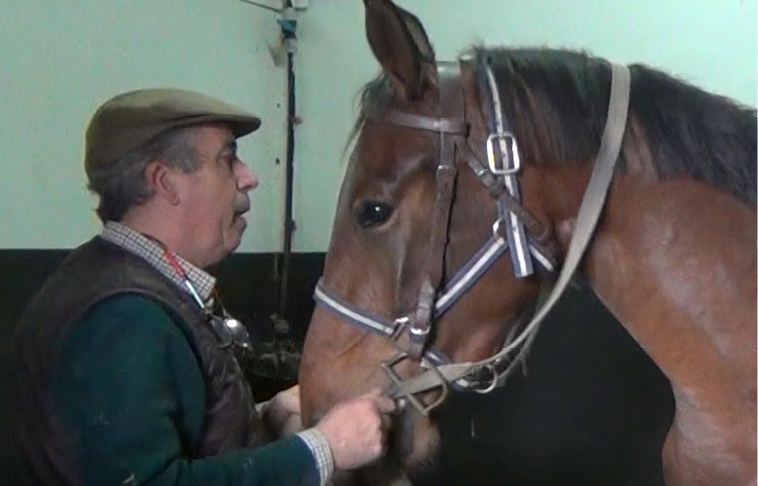
Figure 1: Nicolas Blondeau demonstrates the first element of the “traction, voice, stick” (TVB) phase.
Credit: INRAE / École Blondeau
We recorded the voices of eight trainers as they worked with the horses. All trainers worked with two horses, one male and one female. The trainers were four women (Coline, Elsa, Aurélie, and Zineb) and four men (Manu, Nicolas, Philippe, and Steven); all trainers at the École Blondeau were either professional riders or in training. The age of the trainers is not related to their professional experience, and they each come from diverse backgrounds. Coline is from a family of riders. She came to train to be able to work in the family equestrian centre. Elsa is a rider and riding instructor and wanted to learn how to train young horses to perfect her equestrian knowledge. Zineb comes from Morocco, where she practices show jumping, and she came to France to discover French traditional horse riding. These three riders were, at the time of the study, trainees in continuing education at the school. Aurélie, temporarily engaged as a trainer, is a professional rider. Steven has made his entire career in racing as a training rider and was finishing his retraining at the school. Philippe, a driving instructor, comes back regularly to the school to maintain his skills. Nicolas and Manu are regular riders and instructors at the school.
The trainers’ voices were processed using Pro Tools software and analysed by Patrice Peyriéras, who came to the school’s stables and spent three days with the team (25–28 November 2019). The recordings were made during the TVB stage, while Peyriéras was located in a monitoring room above the box where the horses and trainers were working. He then studied each of the voices. The recording of the trainers’ voices was therefore done in the same place, with the same equipment, and in the same working situation. Moreover, at the same time as we recorded the voices on a computer, we filmed the work sequence. We filmed with a stationary camera. It is a medium shot where you can always see the trainer and the horse. We processed the videos with behavioural coding software The Observer XT and recorded the contact gestures. We thus have an audio recording and a video recording (approximately ten minutes) of all sessions.
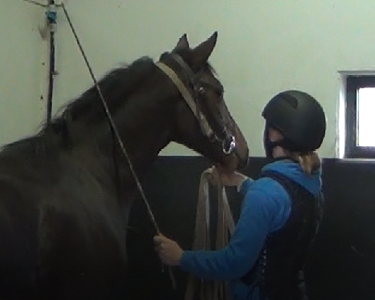
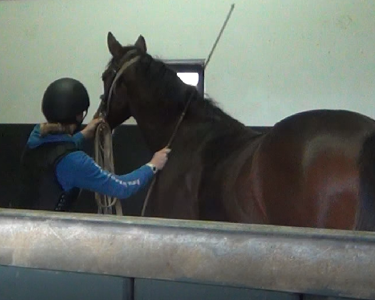
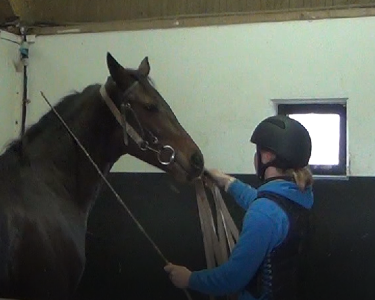
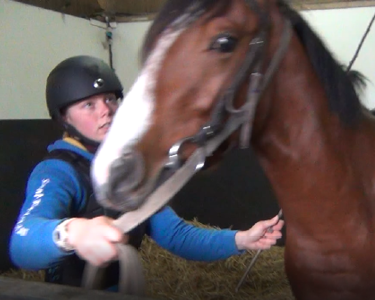
Figure 2a–2d: Coline practicing TVB.
Credit: INRAE / École Blondeau
Voice and Speech in the First Training of the Young Horse at Work
Tessitura is the set of sounds that can be emitted by a voice or by an instrument. In humans, the tonal range is gendered. The common vocal tessitura for men, we find, is on the low end: bass, bass baritone, baritone, tenor, and countertenor. For women, it is higher, with the tessitura often falling in the range of contralto, mezzo-soprano, and soprano. However, within a working context with horses, all trainers sought out the typically masculine range.
The results of our study show that both male and female trainers seek to place their voices in the low-medium and medium range, even the highest voices like Zineb’s. As Peyriéras explains, if we refer, for example, to the keyboard of a piano, we find the high notes at one end and low notes at the other. By analogy, one can say that the trainers’ voices are situated more or less in the middle of the keyboard and, as Peyriéras explains, they “always seek downward, towards a sound lower than [their] spoken voice.” There is, he notes, in this search for a lower tessitura, a desire to envelop and cradle. The syllables are lengthened and repeated. There are many pauses of a few seconds, before the voice resumes soft, warm, and low. The tone rises or falls according to the intensity of the action.
Musical Phrases and Ternary Rhythms
While we observed the presence of this low tessitura, we were also interested in the rhythm that the trainers applied to their voices when talking to the horses. Rhythm in music is what determines the duration of the notes in relation to each other and serves as a basis for melodic placement. The best known are the binary rhythms (each beat is divided in two: TA-ka, TA-ka, TA-ka) and ternary rhythms (each beat is divided in three: OOM-pa-pa, OOM-pa-pa, OOM-pa-pa). By listening to the voices, Peyriéras noticed that there was a homogeneous rhythm and tessitura for each sequence of each trainer.
We also observed that Nicolas Blondeau, and Manu to a lesser extent, built musical phrases on a ternary rhythm. This rhythm remains regular regardless of the context and the attitude of the horse. Indeed, Peyriéras illustrates the presence of a ternary (dactylic) rhythm in the sentences of Nicolas Blondeau and Manu by the fact that he can beat the measure on their words as if he had his musicians play a waltz: “A-ller-bien, A-ller-bien, A-ller-bien…” or “OUI-oui-bien, OUI-oui-bien, OUI-oui-bien…” and so on. Thus, whether the horse is resisting the rider’s request or being cooperative and positive, the rhythm tends towards the same three-beat structure. We find this ternary rhythm throughout the training stage studied.
Impact of Voice on Horse Behaviour
A 2016 study conducted by the Mammal Vocal Communication and Cognition Research Group at the University of Sussex investigated horses’ ability to discriminate between human voices based on their “positive” (laughter) or “negative” (growl) valences. Their results show alert postures when it comes to “negative” voices and calm postures when it comes to “positive” voices.23 We can see that horses are sensitive to voice modulations and change their behaviour accordingly by altering their contact gestures.
In our study, during the video observation of horses in a real work situation, we noticed that the horse regularly made contact with the human by touching them with the tip of their nose. This “contact gesture” is called “touch” in experimental studies on social cognition. It is interpreted as a gesture that expresses the horse’s attention towards the human.24 In the behavioural repertoire of the horse, the moments when horses are in contact are related to social acts, such as grooming behaviours. These behaviours in horses are considered positive gestures marking the affinity between two individuals.25 However, contact gestures are also closely linked to trainers’ voices.
In an 1828 treatise on the art of shoeing intractable horses, the Austro-Hungarian cavalry captain Constantin Balassa describes this same contact gesture and links it to the voice: “If I raise my voice to a horse, he will either recoil or advance, for the harsh sound of the human voice has almost the same effect on the horse as cracking a whip; if, on the other hand, I speak to the horse in a gentle voice, he will rest his head on my shoulder in a friendly manner and obey me willingly in all things, especially if he is already accustomed to being treated in this way.”26 This nineteenth-century text provided further inspiration for our study, and we therefore thought we would link this contact gesture with the trainers’ voices and investigate whether there was any correlation between the voice (tessitura and rhythm) and the horses’ behaviour at the École Blondeau. As such, we watched the eight videos synchronized with the recorded voices and noted the number of contact gestures initiated by the horses. Meanwhile, we also observed the links between the trainer’s voice and co-verbal gestures (for example, voice and pointing gestures). In so doing, we noticed that affectionate contact initiated by the horse triggered tender words in a positive, calm, or low tone from the trainers during these initial training stages. In these moments, a chain of reciprocal recognition behaviours was initiated.
The results of these observations are clear. The tessitura of the voices is directly linked to the number of contact gestures received, and the voices that elicit the most contact gestures are the lowest pitched, i.e. those that remain in the same tessitura whatever the context. In contrast, those trainers with no contact gestures tended to express themselves in voices that were out of tune with their gestures. With his deep voice and structured rhythm, Nicolas Blondeau clearly had more contact gestures than any other trainer. On average, Nicolas had sixteen contact gestures from the two horses he worked with over the period of ten minutes of video recording. Emmanuel had thirteen, Philippe eight, Aurélie five, Steven three, and Elsa and Zineb none. The female trainer with the most contact gestures, Aurélie, also has the deepest of the female voices and one of the most ordered.
Talking to Babies, Talking to Horses?
Infant-Directed Speech (IDS) has been extensively studied. It has a high frequency, rising intonation, and syntactic parameters (short sentences with many repetitions); it is marked by what Anne Karpf calls “a melody of intimacy”. As she explains: “‘baby talk’ envelops toddlers in warmth while helping them understand language and the rules of conversation. It is hard to imagine any other human faculty capable, with so little effort, of such developmental feats.”27 Prat points out that this “baby talk” is universal among humans: “It consists, from the baby’s first year until he or she is three years old, of accented speech, peaks of intonation, marked endings of sentences, greater frequency of labials (m, b, f, v), higher pitch.” She states that rhythm, i.e., temporal organization, is the essential factor in emotional tuning.28 To stimulate the baby, mothers will tend to use higher notes, whereas when they want to soothe the baby, they will usually lower the pitch of their voices.29
The way we typically talk to animals shares many similarities with IDS. For example, in Bernard Martino’s influential documentary film, Le Bébe est une personne (“Baby Is a Person”, 1984), the American paediatrician T. Berry Brazelton speaks to the infants as the trainers speak to their horses, with a beautiful deep voice repeating the name of an infant girl named Shannon. Just as the trainers say “Voilà, voilà, voilà”, Brazelton intones “Come on, come on, come on,” “Shannon, Shannon, Shannon” and so on.30 In both cases, it is a soft and caressing yet serious voice meant to communicate the importance of the moment. Scholars have also pointed to some key differences between IDS and talking to animals, however.31 In the literature, Pet-Directed Speech (PDS) is often described as rising in pitch.32 With regard to dogs, however, Sarah Jeannin points out that deep tones are effective in making the animal sit and wait, while high frequencies encourage the animal to come.33
Analysis of the voices of the École Blondeau trainers shows commonalities with both IDS and PDS, including rudimentary syntax and stressed syllables. However, we observed that both male and female trainers tend to use medium or low tessituras rather than high ones. These shifts in tessituras differentiate our results from other works already produced on horses.34 Our hypothesis is that these differences come from the experimental protocol adopted. In other experiments, the observation of the horses’ sensitivity to PDS was conducted only in connection to the studies on the pointing gesture, which was intended to stimulate the animal. In those cases, the high tessitura also is mobilized, as in IDS, to stimulate the animal. However, in our field, we are in a real work situation with a young horse that is entering work. Therefore, the aim of the trainers, by going in the low tessitura, is to calm the animal down, put it at ease, and generate confidence, while it is in a formative and stressful transition away from the world of fellow equines to the world of training and humans.
Furthermore, it is also known that the horse’s hearing is more comfortable perceiving sounds in the conversational zone, i.e. in the medium range.35 A human voice at mid-range and low mid-range can thus quite effectively heard by horses. Furthermore, as our results confirm, horses are able to differentiate between high and low voice modulations.
Voice and Body Techniques: Joining Gesture and Speech
But does the tessitura of the voice alone explain this difference in the attention shown by the horses to the trainers? The discovery of the ternary rhythm in the trainers’ work suggests the horses’ responses are not necessarily linked to the pitch of the voice or to a particular rhythm alone. Instead, we argue, the coherence between the ternary rhythm of the voice and the precision of the gesture is key. A deep voice and a ternary rhythm are not enough in themselves; they are part of body techniques, of “technical gestures”. As the psychologist and anthropologist Blandine Bril clarifies, a technical gesture is “a fluid, embodied gesture, requiring an engagement with the task” and the embodiment of knowledge.36 The precision of the gesture comes from learned and practiced proficiency; a proficiency that brings the appropriate energy to our arms, our fingers, to the tool we may be holding, and to the articulation between all these elements. Working with horses is predominately physical, requiring few tools other than the trainer’s own body. Arms, hands, posture, voice, tone, energy, and modulation of everything together constitute what Marcel Mauss calls “techniques of the body”, and they create linguistic ties to the horses, to which the horses in turn respond.37
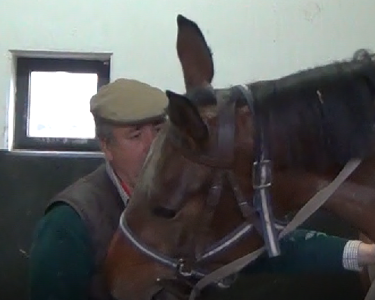
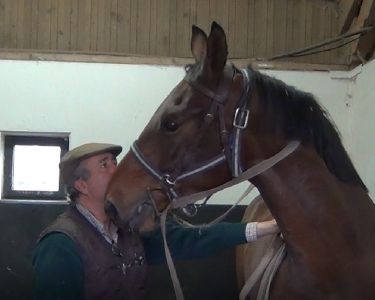
Figure 3a and 3b: First and second contact gesture.
Credit: INRAE / École Blondeau
As we have seen, the observation of horses in real work situations brings new data on the relationship between the voice and the technical gesture of the trainer. If horses are more likely to touch trainers whose utterances follow a ternary rhythm, it is also because they are the ones who have the most technical precision. Their voice is precisely tuned to their gestures, and their bodily language. For instance, when they say “A”, they pull on the horse’s mouth. When they say “-ller”, they touch the stick to the horse’s shoulder. When they say “bien”, they release the traction and the horse moves towards the rider. The voice and the gesture are perfectly synchronized, and they can repeat this synchronization several times in a row until the horse has fully understood the mode of communication that the trainer is teaching them. On the other hand, if the gesture is clumsy, if the trainer has not integrated the technique, the instructions given to the horse will be confused and the trainer will be partly detached from their relationship with the horse.
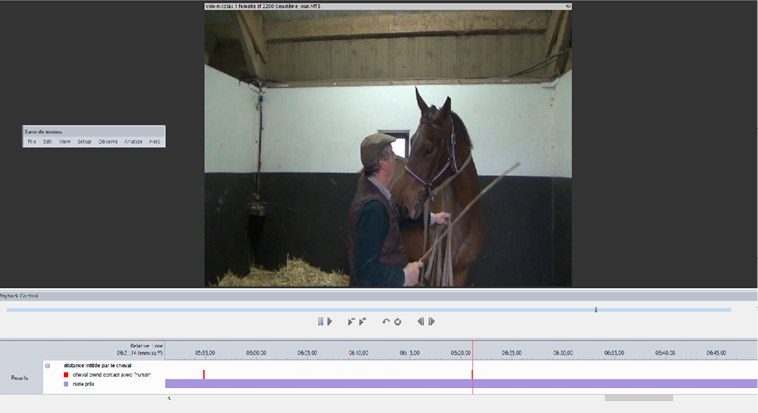
Figure 4: Analysis of contact gesture in The Observer TX software.
Credit: INRAE / École Blondeau
Because trainers have incorporated the technical gestures, they can invest in the relationship with the horses and be attentive to them, while anticipating their behaviour to a certain extent. In return, the coherence between the voice and the gesture makes the rider’s requests coherent in the eyes of the horse, allowing the horse to likewise anticipate what will be asked of them. When gesture and body are coherent, the horse cannot be surprised, and can foresee what will happen, which predictability creates calmness and an environment conducive to better learning.
We were able to observe this synchronization and its effects on the relationship with the horse because we conducted our observations in a real work situation (with its needs, changing relationships, and ongoing mediation of desires). Whereas in an experimental situation, the context must artificial in order to ensure control of all of the experiment’s parameters. This prevents observers from seeing the unexpected and watching human and animal negotiate together the real work scenarios central to the horse–human relationship. It is because we are in the field of social sciences, and more specifically in the field of labour studies, that we approach our questions in connection with reality,38 and this allows us to be open to what is actually happening in the day-to-day work and life with horses.
Conclusion
In work, humans and horses build intersubjective relationships. “Breaking-in” is the beginning of the development of this intersubjectivity. Step by step, day by day, the rider and the young horse develop a partnership based on affectivity. They connect their bodies in concert, and this agreement is heard because the voice is the echo of it. When young horses begin to be “broken in” they enter training; they discover the world of work in which they will participate for many years. This discovery is made through the body, and it is the body that is the vector of the relationship with the material, with the tool, and with the other. In the learning stage that we observed, it is a question of the horse’s understanding the mode of communication that the human will always use in training and riding to give information. The coherence of the message sent is thus essential to working well together, and if the initial message from the trainer to the young horse is completely coherent, the horse will have an easier transition into the strange and new world of work.
For the psychodynamics of work, this means work holds the promise of fulfilment or the fate of submission. If we recognize the worker’s capacity for intelligence and initiative, she will be able to complete her work well. On the contrary, if what counts is blind obedience and submission, the personality of the worker will be suppressed and destroyed by the work. Seeing things this way leads us to take a new look at our relationships with animals, one that is much more complex than the one we have had until now. With this complexity, we can ask new questions and provide new answers to change our working relationships. As Christophe Dejours expresses it: “The field of work shows aspects of animals that cannot be seen outside the field of work.”39 Indeed, talking about animals as workers raises new ethical questions that shift the question of animal welfare and allow us to move away from a simple zootechnical approach. This leads to more subtle questions, such as the possibility of a right to fulfilling and positive animal labour.
Acknowledgements
The authors would like to thank Anne Karpf, Patrice Peyriéras, and the trainers at the École Blondeau. Warmest thanks to Monica Mattfeld and Kári Driscoll for their writing and editorial support.
Notes
-
Briefer, “Vocal Contagion of Emotions”; Trösch et al., “Horses Categorize Human Emotions”.
-
Stern, Les Formes de vitalité; Mondémé, “Comment parle-t-on aux animaux?”; Karpf, The Human Voice; Jeannin et al., “Pet-Directed Speech”, 201.
-
Dejours et al., The Return of Work.
-
Gernet and Dejours, “Evaluation du travail”, 28. Unless otherwise indicated, all translations are our own.
-
Dejours and Deranty, “Centrality of Work”, 170.
-
Dejours and Deranty, “Centrality of Work”, 172.
-
Dejours and Deranty, “Centrality of Work”; Porcher and Estebanez, Animal Labor.
-
Porcher, Éleveurs et animaux; Salmona, Les Paysans français.
-
Porcher, Éleveurs et animaux.
-
Mouret, Porcher, and Mainix, “Military and Police Dogs”.
-
Porcher, “Well-Being and Suffering”.
-
See Porcher and Schmitt, “Dairy Cows”; Porcher, “Animal Work”; Porcher and Lécrivain, “The Wolf”; Porcher and Lécrivain, “Bergers, chiens, brebis”; Porcher and Barreau, “Le Débourrage”; Mouret, “Apprendre à prendre soin”; Mouret, “Chiens de patrouille”; Lainé, Living and Working; Haraway, Companion Species Manifesto; Estebanez, Porcher, and Douine, “Travailler à faire semblant”; Deneux, “Les Chevaux ”; Dray, “Du cheval exécutant”; Dray, “Technozoosemiotics”; Mulier and Porcher “Service hippomobile”.
-
Porcher, “The Work of Animals”, 1-9.
-
Brandt, “Language of Their Own”; Game, “Riding”.
-
Blattner, Coulter, and Kymlicka, Animal Labour, 11.
-
Trösch et al., “Horses Categorize Human Emotions”.
-
Giovanni, Lagier, and Bernardoni, “Physiologie de la phonation”.
-
Leroi-Gourhan, La Civilisation du renne.
-
Prat, “Prendre une voix”, 29.
-
Winnicott, Babies and Their Mothers.
-
Castarède, “Métapsychologie de la voix”.
-
Baucher, Méthode d’équitation.
-
Smith et al., “Domestic Horses”.
-
Lansade et al., “Horses are Sensitive”; Trösch et al., “Horses Categorize Human Emotions”; Ringhofer and Yamamoto, “Domestic Horses Send Signals”.
-
Shimada and Suzuki, “Contribution of Mutual Grooming”.
-
“Wenn ich ein Pferd scharf anrufe, so wird es zurück oder vorwärts prallen; so daß der scharfe Ton der menschlichen Stimme auf das Pferd beynahe die Wirkung eines Peitschenhiebes äußert; spreche ich hingegen zu dem Pferde mit sanfter Stimme, so legt es mir freundlich den Kopf auf die Schultern, und gehorcht mir willig in Allem; besonders es einmal an diese Behandlungsart gewöhnt ist.” Balassa, Der Hufbeschlag, 18.
-
Karpf, The Human Voice, xx, 149.
-
Prat, “Prendre une voix”, 31.
-
Fernald, “Perceptual and Affective Salience”; Bouteloup, “Berceuses pour petits”; Karpf, The Human Voice; Golse and Simas, “La Question du rythme”.
-
Martino, Le Bébe est une personne, 1:31:50–1:43:30.
-
Jeannin, “La Relation homme–animal”; Mondémé, “How Do We Talk to Animals?”
-
Lansade et al., “Horses Are Sensitive”; see also Mondémé “How Do We Talk to Animals?”
-
Jeannin, “La Relation homme–animal”, 36.
-
See, for instance, Lansade et al., “Horses Are Sensitive”; Mondémé, “Une linguistique”.
-
See Leblanc, L’Esprit du cheval.
-
Bril, “Comment aborder la question”, 71, 79.
-
Mauss, “Techniques of the Body”.
-
Porcher and Schmitt, “Dairy Cows”.
-
Christophe Dejours, concluding remarks at the first Animal’s Lab Rencontres symposium, AgroParisTech, Paris, France, 8–9 April 2016.
Works Cited
Balassa, Constantin. Der Hufbeschlag ohne Zwang. Vienna, 1828. https://books.google.com/books?id=f8xTAAAAcAAJ.
Baucher, François. Méthode d’équitation basée sur de nouveaux principes. 10th ed. Paris: Librairie Militaire, 1854. http://ark.bnf.fr/ark:/12148/cb30066263h.
Blattner, Charlotte E., Kendra Coulter, and Will Kymlicka, eds. Animal Labour: A New Frontier of Interspecies Justice? Oxford: Oxford University Press, 2020.
Bouteloup, Philippe. “Berceuses pour petits et grands.” Spirales 34, no. 2 (2005): 51–60. https://doi.org/10.3917/spi.034.0051.
Brandt, Keri. “A Language of Their Own: An Interactionist Approach to Human–Horse Communication.” Society & Animals 12, no. 4 (2004): 299–316. https://doi.org/10.1163/1568530043068010.
Briefer, Elodie F. “Vocal Contagion of Emotions in Non-Human Animals.” Proc. R. Soc. B. 285, no. 1873 (Feb. 2018): 20172783. http://doi.org/10.1098/rspb.2017.2783.
Bril, Blandine. “Comment aborder la question du geste technique pour en comprendre l’expertise et l’apprentissage?” Techniques & Culture 1, no. 71 (2019): 78–91. https://doi.org/10.4000/tc.11373.
Castarède, Marie France. “Métapsychologie de la Voix.” Champ psychosomatique 48, no. 4 (2007): 7–21. https://doi.org/10.3917/cpsy.048.0007.
Coulter, Kendra. Animals, Work, and the Promise of Interspecies Solidarity. Basingstoke: Palgrave Macmillan, 2016.
Dejours, Christophe, and Jean-Philippe Deranty. “The Centrality of Work.” Critical Horizons, 11, no. 2 (2010): 167–180. https://doi.org/10.1558/crit.v11i2.167.
Dejours, Christophe, Jean-Philippe Deranty, Emmanuel Renault, and Nicolas H. Smith. The Return of Work in Critical Theory: Self, Society, Politics. New York: Columbia University Press, 2018.
Deneux-Le Barh, Vanina. “Les chevaux de sécurité publique: des professionnels?” Économie rurale no. 374 (Oct.–Dec. 2020): 91–106. https://doi.org/10.4000/economierurale.8367.
Dray, Charlène. “Du cheval exécutant au cheval actant. Réinventer les relations inter-espèces au travers d’une pratique artistique expérimentale.” Circus Sciences: Revue scientifique en ligne sur les arts du cirque no. 1 (2020): 45–52. https://mediatheque.ifce.fr/index.php?lvl=notice_display&id=69122.
Dray, Charlène. “Technozoosemiotics: Think and Practices of Scenography with the Horse for a Modern Aesthetic Drama.” In Animal Performance Studies, edited by Laura Budriesi, 322–37. Turin: Accademia University Press, 2022. https://doi.org/ 10.4000/books.aaccademia.12480.
Estebanez, Jean, Jocelyne Porcher, and Julie Douine. “Travailler à faire semblant: les animaux au cinéma.” Écologie & Politique 54, no. 1 (2017): 103–21. https://doi.org/10.3917/ecopo1.054.0103.
Fernald, Anne. “The Perceptual and Affective Salience of Mothers’ Speech to Infants.” In The Origins and Growth of Communication, edited by Lynne Feagans, Catherine Garvey, and Roberta Golinkoff, 5–29. Norwood, NJ: Ablex, 1984.
Game, Ann. “Riding: Embodying the Centaur.” Body & Society 7, no. 4 (2001): 1–12. https://doi.org/10.1177/1357034X01007004001.
Gernet, Isabelle, and Christophe Dejours. “Évaluation du travail et reconnaissance.” Nouvelle revue de psychosociologie 8, no. 2 (2009): 27–36. https://doi.org/10.3917/nrp.008.0027.
Giovanni, Antoine, Aude Lagier, and Nathalie Heinrich Bernardoni. “Physiologie de la phonation.” EMC Oto Rhino Laryngologie 9, no. 2 (2014): 1–15. https://hal.science/hal-01427064.
Golse, Bernard and Roberta Simas. “La Question du rythme entre empathie(s) et intersubjectivité(s).” Spirales 44, no. 4 (2007): 59–64. https://doi.org/10.3917/spi.044.0059.
Haraway, Donna. The Companion Species Manifesto: Dogs, People, and Significant Otherness. Chicago: Prickly Paradigm Press, 2003.
Jeannin, Sarah. “La Relation homme–animal: Étude de la communication vocale adressée au chien (Canis familiaris).” PhD Diss., Université Paris Nanterre, 2016. https://www.theses.fr/2016PA100172.
Jeannin, Sarah, Caroline Gilbert, Amy Mathieu, and Gérard Leboucher. “Pet-Directed Speech Draw Adult Dogs’ Attention More Efficiently than Adult-Directed Speech.” Scientific Reports 7 (2017): 4980. https://doi.org/10.1038/s41598-017-04671-z.
Karpf, Anne. The Human Voice: How This Extraordinary Instrument Reveals Essential Clues about Who We Are. New York: Bloomsbury, 2006.
Lainé, Nicolas. Living and Working with Giants: A Multispecies Ethnography of the Khamti and Elephants in Northeast India. Paris: Muséum National d’Histoire Naturelle, 2020.
Lansade, Léa, Miléna Trösch, Céline Parias, Alice Blanchard, Elodie Gorosurreta, and Ludovic Calandreau. “Horses Are Sensitive to Baby Talk: Pet-Directed Speech Facilitates Communication with Humans in a Pointing Task and During Frooming.” Animal Cognition 24, no. 5 (2021): 999–1006. https://doi.org/10.1007/s10071-021-01487-3.
Leblanc, Michel-Antoine. L’Esprit du cheval. Introduction à l’éthologie cognitive du cheval. Intelligence, cerveau, perception. Paris: Belin, 2010.
Leroi-Gourhan, André. La Civilisation du renne. Paris: Gallimard, 1936.
Martino, Bernard, dir. Le Bébe est une personne. TF1 1984. 183 minutes. Available on YouTube: https://youtu.be/3YzV-yWMVW0.
Mauss, Marcel. “Techniques of the Body.” 1934. Translated by Ben Brewster. Economy and Society 2, no. 1 (1973): 70–88. https://doi.org/10.1080/03085147300000003.
Mondémé, Chloé. “Comment parle-t-on aux animaux? Formes et effets pragmatiques de l’adresse aux animaux de compagnie.” Langage et société 163, no. 1 (2018): 77–99. https://doi.org/10.3917/ls.163.0077.
Mondémé, Chloé. “Une linguistique au-delà de l’humain? Les vertus heuristiques de la semiosis inter-espèce.” Itinéraires. Littérature, textes, cultures, no. 2020-2 (2020). https://doi.org/10.4000/itineraires.8453.
Mouret, Sébastien. “Apprendre à prendre soin: La centralité du travail dans l’éducation des chiens guides d’aveugles.” Écologie & politique 54, no. 1 (2017): 87–102. https://doi.org/10.3917/ecopo1.054.0087.
Mouret, Sébastien. “Les Chiens de patrouille de la police nationale: les gueules armées de la République.” Sociologie du travail 60, no. 2 (April–June 2018). https://doi.org/10.4000/sdt.2040.
Mouret, Sébastien, Jocelyne Porcher, and Gaelle Mainix. “Military and Police Dogs: Weapons or Colleagues?” In Porcher and Estebanez, Animal Labor, 129–45.
Mulier, Chloé and Jocelyne Porcher. “Le Service hippomobile de Vendargues: Un collectif interspécifique de travail.” Natures Sciences Sociétés 30, no. 1 (2022): 31–45. https://doi.org/10.1051/nss/2022020.
Porcher, Jocelyne. “Animal Work.” In The Oxford Handbook of Animal Studies, edited by Linda Kalof, 302–18. Oxford: Oxford University Press, 2017.
Porcher, Jocelyne. Éleveurs et animaux, réinventer le lien. Paris: Presses Universitaires de France, 2002.
Porcher, Jocelyne. “The Work of Animals: A Challenge for Social Sciences.” Humanimalia 6, no. 1 (2014): 1–9. https://doi.org/10.52537/humanimalia.9925.
Porcher, Jocelyne. “Well-Being and Suffering in Livestock Farming: Living Conditions at Work for People and Animals.” Sociologie du Travail 48, Supplement 1 (August 2006): e56–e70. https://doi.org/10.1016/j.soctra.2006.02.001.
Porcher, Jocelyne and Sophie Barreau. “Le Débourrage des jeunes chevaux, un terrain inattendu pour la psychodynamique du travail?” Travailler 41, no. 1 (2019): 153–169. https://doi.org/10.3917/trav.041.0153.
Porcher, Jocelyne and Jean Estebanez, eds. Animal Labor: A New Perspective on Human–Animal Relations. Bielefeld: Transcript, 2019.
Porcher, Jocelyne and Élisabeth Lécrivain. “Bergers, chiens, brebis: un collectif de travail naturel?” Études rurales no. 189 (2012): 121–37. https://doi.org/10.4000/etudesrurales.9615.
Porcher, Jocelyne and Élisabeth Lécrivain. “The Wolf and the Patou Dog: Freedom and Work.” In Porcher and Estebanez, Animal Labor, 113–27.
Porcher, Jocelyne and Tiphaine Schmitt. “Dairy Cows: Workers in the Shadows?” Society & Animals 20, no. 1 (2012): 39–60. https://doi.org/10.1163/156853012X614350.
Prat, Régine. “Prendre une voix dans ses bras.” Enfances & Psy 58, no. 1 (2013): 29–39. https://doi.org/10.3917/ep.058.0029.
Ringhofer, Monamie and Shinya Yamamoto. “Domestic Horses Send Signals to Humans When They Are Faced with an Unsolvable Task.” Animal Cognition 20, no. 3 (2017): 397–405. https://doi.org/10.1007/s10071-016-1056-4.
Salmona, Michèle. Les Paysans français. Le travail, les métiers, la transmission des savoirs. Paris: L’Harmattan, 1994.
Shimada, Masaki and Nae Suzuki. “The Contribution of Mutual Grooming to Affiliative Relationships in a Feral Misaki Horse Herd.” Animals 10, no. 9 (2020): 1564. https://doi.org/10.3390/ani10091564.
Smith, Amy Victoria, Leanne Proops, Kate Grounds, Jennifer Wathan, Sophie K. Scott, and Karen McComb. “Domestic Horses (Equus caballus) Discriminate between Negative and Positive Human Nonverbal Vocalisations.” Scientific Reports no. 8 (2018): 13052. https://doi.org/10.1038/s41598-018-30777-z.
Stern, Daniel. Les Formes de vitalité. Psychologie, art, psychothérapie et développement de l’enfant. Paris: Odile Jacob, 2010.
Trösch, Miléna, Florent Cuzol, Céline Parias, Ludovic Calandreau, Raymond Nowak, and Léa Lansade. “Horses Categorize Human Emotions Cross-Modally Based on Facial Expression and Non-Verbal Vocalizations.” Animals 9, no. 11 (2019): 862. https://doi.org/10.3390/ani9110862.
Winnicott, D. W. Babies and Their Mothers. Edited by Clare Winnicott, Ray Shepherd, and Madeline Davis. Introduction by Benjamin Spock. Reading, MA: Addison-Wesley, 1987.